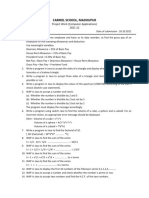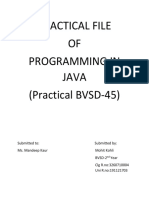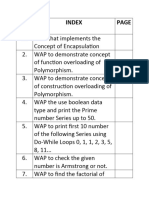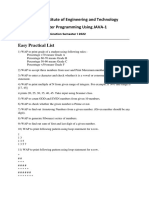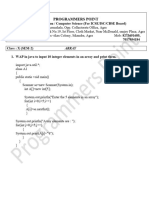0% found this document useful (0 votes)
20 views37 pagesJava GSJ Final
This document is a practical file for Java programming submitted by Gaurav Singh Joon under the guidance of Dr. Ranjeeta Kaur. It includes a comprehensive index of programming tasks such as calculating Fibonacci series, checking for prime numbers, and implementing various Java concepts like inheritance and method overloading. Each task is accompanied by code examples and outputs demonstrating the functionality of the programs.
Uploaded by
Gaurav Singh JoonCopyright
© © All Rights Reserved
We take content rights seriously. If you suspect this is your content, claim it here.
Available Formats
Download as DOCX, PDF, TXT or read online on Scribd
0% found this document useful (0 votes)
20 views37 pagesJava GSJ Final
This document is a practical file for Java programming submitted by Gaurav Singh Joon under the guidance of Dr. Ranjeeta Kaur. It includes a comprehensive index of programming tasks such as calculating Fibonacci series, checking for prime numbers, and implementing various Java concepts like inheritance and method overloading. Each task is accompanied by code examples and outputs demonstrating the functionality of the programs.
Uploaded by
Gaurav Singh JoonCopyright
© © All Rights Reserved
We take content rights seriously. If you suspect this is your content, claim it here.
Available Formats
Download as DOCX, PDF, TXT or read online on Scribd
/ 37

